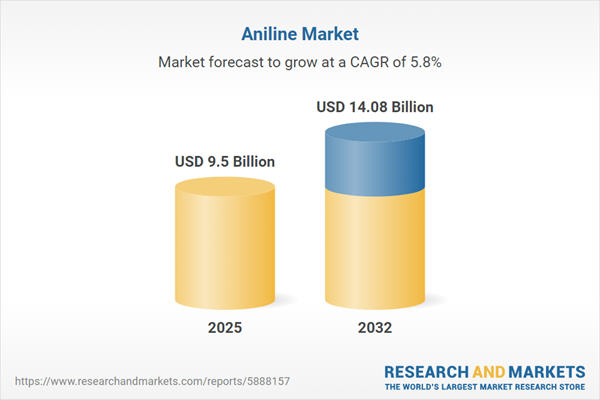Speak directly to the analyst to clarify any post sales queries you may have.
Aniline is integral to the modern industrial landscape, driving innovation, sustainability, and resilience across chemical and advanced materials markets. For senior leaders, shifts in the aniline market unlock strategic pathways to outpace competition and reinforce operational adaptability.
Market Snapshot: Aniline Market Size and Growth Outlook
The aniline market is experiencing consistent expansion, with a current valuation of USD 8.97 billion set to grow to USD 9.50 billion by 2025 and projected to reach USD 14.08 billion in 2032. This performance is driven by a compound annual growth rate (CAGR) of 5.78%. Key factors contributing to this trend include increased adoption of performance chemicals, heightened compliance with industry regulations, and rapid deployment of production innovations. These dynamics position the aniline market as a focal point for strategic planning, operational resilience, and supply chain optimization for senior leadership teams globally.
Scope & Segmentation
- End Use: Aniline serves as a foundation for advancements in agrochemicals supporting crop protection; high-performance dyes and pigments used in textiles, coatings, and industrial applications; specialty intermediates for the pharmaceutical sector; and rubber antioxidants enhancing durability and quality for manufacturers. Each application addresses evolving quality and efficiency expectations across industrial sectors.
- Form: With both liquid and solid forms available, aniline allows manufacturers to align supply with technical requirements and processing preferences, supporting seamless adaptation in various workflows.
- Purity: Commercial grade aniline is specified for broad industrial use, while electronic grade solutions supply high-consistency demands in advanced sectors such as semiconductor manufacturing, ensuring product uniformity.
- Production Process: Key methodologies include catalytic hydrogenation, leveraging nickel and palladium catalysts, as well as nitrobenzene and sulfite processes. These technologies support efficient scaling, regulatory compliance, and customization for end-user applications.
- Geographies: The market covers the Americas—including the United States, Canada, Mexico, Brazil, Argentina, Chile, Colombia, and Peru—as well as EMEA with markets such as the United Kingdom, Germany, France, and Russia. The Asia-Pacific portfolio includes China, India, Japan, Australia, South Korea, and Southeast Asia, each offering distinctive growth and demand dynamics.
- Key Players: Major industry participants include Covestro AG, Huntsman International LLC, BASF SE, Saudi Basic Industries Corporation, Solvay SA, Mitsubishi Chemical Holdings Corporation, Mitsui Chemicals, Arkema SA, LANXESS AG, and Dow Inc., collectively shaping production standards and global competitiveness.
Aniline Market: Key Takeaways for Senior Leaders
- Aniline applications are diversifying across sectors, supporting next-generation product development in dyes, pharmaceuticals, and advanced rubber materials to address future industry and consumer needs.
- Manufacturers implementing advanced catalysis and membrane-based technologies are achieving measurable reductions in environmental impact and optimizing resource use, strengthening both compliance and efficiency initiatives.
- Adoption of bio-based feedstocks enables companies to meet emerging regulatory expectations and future-proof supply chains, supporting long-term business continuity and market access.
- Strategic alliances with partners in related fields accelerate the adoption of new technologies and further align production with evolving technical benchmarks, facilitating nimble responses to market shifts.
- By expanding sourcing channels and reinforcing value chains, organizations increase resilience against disruptions from policy changes or logistical barriers, ensuring sustained competitiveness in variable global markets.
Tariff Impact: Aniline Industry Supply Adjustments and Competitive Responses
Recent tariffs targeting aniline and its intermediates in the United States are prompting companies to revisit procurement models and invest in domestic production facilities, resulting in improved supply reliability. These measures also intensify global competition, as international suppliers leverage geographic and cost differentials. To ensure continuous operations, organizations are forming new resource partnerships, securing inventories, and exploring alternative sourcing, maintaining their strategic edge under evolving trade pressures.
Production Technology and Regional Market Dynamics
Catalytic hydrogenation and continuous flow reactor integration sit at the core of production modernization in established manufacturing regions, delivering cost and operational gains. The Asia-Pacific market remains a significant consumption hub due to robust demand in textiles and electronics, while North America and Europe provide a foundation of stable infrastructure and increasing focus on sustainability. In the Middle East, manufacturers capitalize on domestic resource advantages to expand capacity, and African markets invest in downstream production to capture emerging segment growth.
Methodology & Data Sources
Our research synthesizes primary interviews with industry executives alongside comprehensive secondary analysis. Insight is triangulated from technical literature, official market data, and proprietary internal resources to deliver actionable and validated recommendations tailored for strategic planning.
Why This Report Matters
- Provides senior leaders with benchmark-ready insights to navigate changing technology landscapes, regulatory pressures, and sustainability imperatives in the aniline industry.
- Delivers actionable intelligence on supply chain resilience, enabling informed decisions to enhance competitiveness and support strategic growth in uncertain markets.
Conclusion
This analysis equips executives with the knowledge to anticipate sector changes, optimize supply networks, and make data-driven decisions that drive sustainable growth within the aniline market.
Additional Product Information:
- Purchase of this report includes 1 year online access with quarterly updates.
- This report can be updated on request. Please contact our Customer Experience team using the Ask a Question widget on our website.
Table of Contents
3. Executive Summary
4. Market Overview
7. Cumulative Impact of Artificial Intelligence 2025
List of Figures
Samples

LOADING...
Companies Mentioned
The key companies profiled in this Aniline market report include:- Covestro AG
- Huntsman International LLC
- BASF SE
- Saudi Basic Industries Corporation
- Solvay SA
- Mitsubishi Chemical Holdings Corporation
- Mitsui Chemicals, Inc.
- Arkema SA
- LANXESS AG
- Dow Inc.
Table Information
| Report Attribute | Details |
|---|---|
| No. of Pages | 197 |
| Published | October 2025 |
| Forecast Period | 2025 - 2032 |
| Estimated Market Value ( USD | $ 9.5 Billion |
| Forecasted Market Value ( USD | $ 14.08 Billion |
| Compound Annual Growth Rate | 5.7% |
| Regions Covered | Global |
| No. of Companies Mentioned | 11 |









